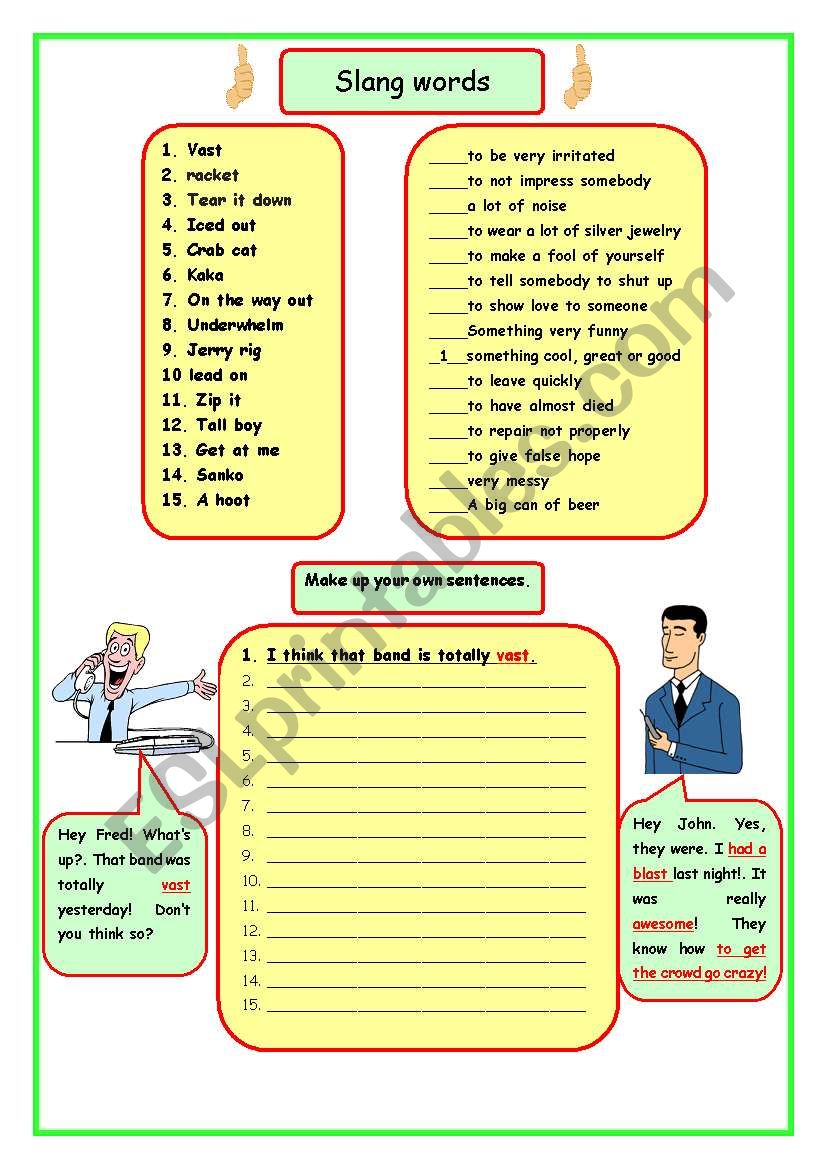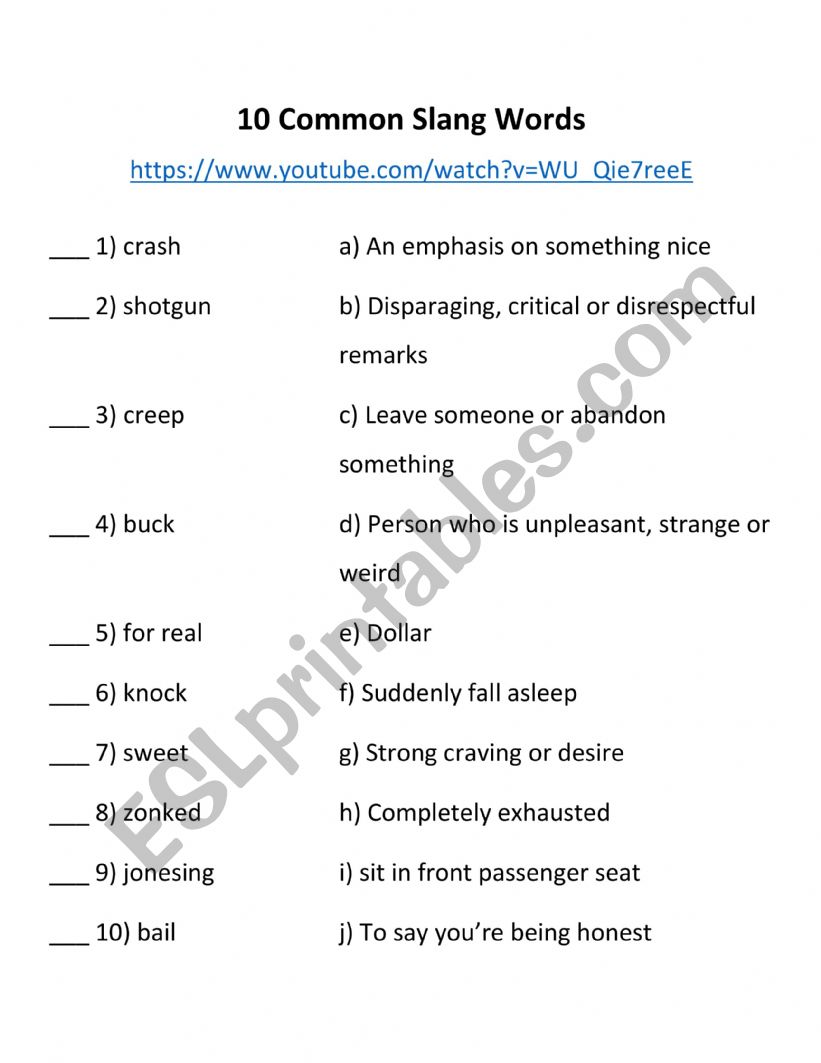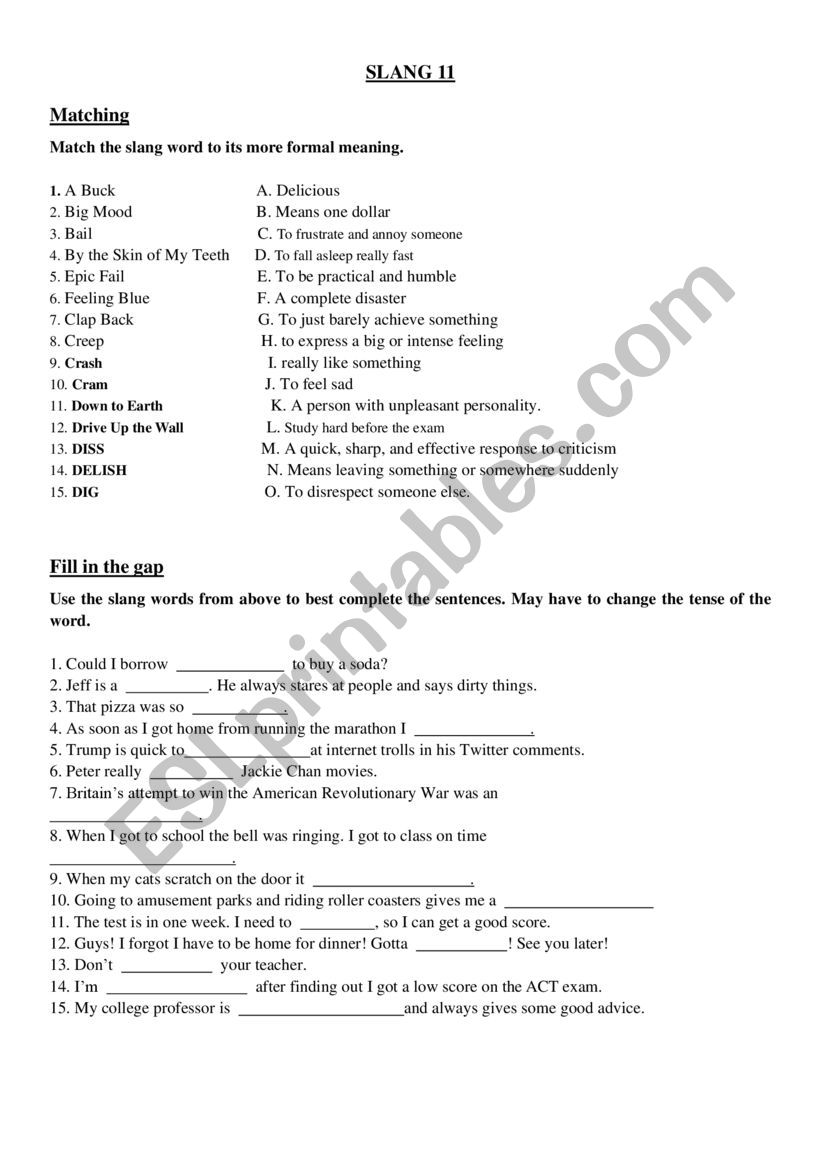
Unlocking Modern Language: The Transformative Power of Slang Worksheets
Language is a living, breathing entity, constantly evolving, adapting, and mirroring the societies that speak it. While formal grammar and traditional vocabulary form the bedrock of linguistic education, a significant and often overlooked component of authentic communication lies in the realm of slang. Slang, the informal, often fleeting, lexicon of a particular group or period, provides a vital window into cultural nuances, social trends, and real-world interactions. For language learners, educators, and even native speakers looking to stay current, bridging the gap between textbook language and lived experience is crucial. This is where slang worksheets emerge as an invaluable, dynamic tool.
This comprehensive article delves into the profound importance of incorporating slang into language learning, explores the multifaceted benefits of using dedicated slang worksheets, discusses best practices for their creation and implementation, and highlights their role in fostering true linguistic fluency and cultural understanding.
The Ever-Evolving Lexicon: Why Slang Matters

From Shakespearean insults to modern-day internet memes, slang has always been an integral part of human communication. It reflects creativity, humor, social identity, and often, a rebellion against rigid linguistic norms. Ignoring slang in language education is akin to teaching anatomy without discussing physiology – you get the structure, but miss the function and vitality.

For English language learners (ELLs) and those studying English as a Foreign Language (EFL), understanding slang is not just a matter of sounding "cool"; it’s essential for comprehension and effective communication in a variety of real-world contexts. Imagine watching a popular movie, scrolling through social media, listening to a podcast, or engaging in a casual conversation with native speakers – a significant portion of the dialogue will be peppered with slang. Without an understanding of these informal terms, learners can feel lost, isolated, and unable to fully participate in social exchanges.

Moreover, slang provides insights into cultural values, current events, and the emotional landscape of a community. It teaches learners not just what words mean, but how they are used, when they are appropriate, and what they imply about the speaker and the situation. This level of nuanced understanding moves beyond rote memorization to true linguistic and cultural immersion.

What Exactly Are Slang Worksheets?

At its core, a slang worksheet is an educational resource designed to introduce, practice, and reinforce understanding of informal, non-standard vocabulary. Unlike traditional vocabulary exercises that focus on formal definitions, slang worksheets emphasize context, usage, and the ephemeral nature of these terms. They bridge the gap between academic language and the dynamic, ever-changing language used in daily life.
Common formats and activities found in effective slang worksheets include:
- Matching Exercises: Pairing slang terms with their formal definitions or closest synonyms.
- Fill-in-the-Blanks: Using slang terms to complete sentences or short dialogues, emphasizing contextual usage.
- Sentence Creation: Encouraging learners to construct their own sentences using specific slang terms, demonstrating comprehension.
- Contextual Reading Passages: Short stories, dialogues, or social media posts rich in slang, followed by comprehension questions.
- Multiple Choice Questions: Identifying the correct meaning or usage of a slang term in a given scenario.
- Discussion Prompts: Encouraging learners to discuss when and where certain slang terms would be appropriate, fostering critical thinking.
- Role-Playing Scenarios: Practicing the use of slang in simulated real-life conversations.
- Definition Challenges: Learners attempt to define a slang term based on its context before being given the formal meaning.
- Slang Origins/Etymology: Exploring how certain slang terms came into being, adding a historical and cultural dimension.




The best slang worksheets are not merely lists of words; they are interactive tools that promote active engagement, critical thinking, and a deeper appreciation for the subtleties of language.
The Multifaceted Benefits of Incorporating Slang Worksheets
The strategic inclusion of slang worksheets in a language curriculum offers a wealth of benefits for learners across all proficiency levels:
- Enhanced Cultural Understanding: Slang is deeply embedded in culture. Learning terms like "spill the tea" or "ghosting" provides insights into social dynamics, communication trends, and cultural values, helping learners decode implicit meanings and social cues.
- Increased Engagement and Motivation: Let’s face it, grammar drills can be dry. Slang, by its very nature, is often playful, edgy, and relevant to learners’ contemporary lives. Incorporating it can inject excitement and real-world relevance into lessons, making the learning process more enjoyable and memorable.
- Improved Conversational Fluency: Understanding and appropriately using slang can make a learner sound more natural, confident, and less "textbooky." It reduces communication breakdowns and fosters smoother, more authentic interactions with native speakers.
- Bridging the Generational and Social Divide: Slang is often specific to age groups or social circles. Learning it helps younger learners understand their peers and popular media, while older learners can stay connected to contemporary discourse.
- Practical Real-World Application: From deciphering song lyrics and movie dialogue to navigating social media and informal conversations, slang worksheets equip learners with tools directly applicable to their daily lives outside the classroom.
- Vocabulary Expansion Beyond the Textbook: Slang introduces learners to a vast lexicon that traditional textbooks often omit, broadening their overall vocabulary and linguistic repertoire.
- Development of Contextual Awareness: Slang terms often have multiple meanings or are highly context-dependent. Worksheets that provide scenarios force learners to think critically about when and how to use a term, developing crucial contextual awareness.
Designing Effective Slang Worksheets
Creating impactful slang worksheets requires careful consideration to ensure they are both effective and appropriate:
- Authenticity is Key: Source slang from current popular culture, social media, news, and everyday conversations. Outdated slang can be confusing or even humorous in unintended ways.
- Provide Ample Context: Never present slang terms in isolation. Always include them within sentences, dialogues, or short passages that clearly illustrate their meaning and usage.
- Address Timeliness and Regionality: Slang evolves rapidly and varies significantly by region (e.g., British vs. American English, or even within different cities). Acknowledge this fluidity and specify the origin/era of the slang if necessary.
- Consider Level Appropriateness: Start with more common, widely understood slang for beginners, progressing to more niche or complex terms for advanced learners.
- Include a Variety of Activities: Mix matching, fill-in-the-blanks, discussions, and creative writing to cater to different learning styles and keep engagement high.
- Provide Clear Definitions and Explanations: For each slang term, offer a concise, easy-to-understand definition. Include examples of its usage.
- Add Teacher Notes/Answer Keys: Essential for educators, these should provide not only answers but also additional context, usage notes, and potential pitfalls.
- Address Appropriateness and Offensiveness: Some slang can be offensive, vulgar, or highly inappropriate for certain contexts. Educators must exercise discretion, perhaps teaching about such terms (e.g., "This term is considered offensive and should not be used") rather than encouraging their use. Focus on widely accepted, contemporary slang.
Implementing Slang Worksheets in the Classroom and Beyond
Slang worksheets can be integrated into language learning in numerous ways:
- As Warm-ups or Cool-downs: A quick slang exercise can be an engaging way to start or end a class, sparking curiosity and conversation.
- Integrated into Thematic Units: When discussing topics like social media, technology, or current events, incorporate relevant slang.
- For Discussion and Role-Play: After completing a worksheet, encourage learners to use the new slang in spontaneous conversations or role-playing scenarios.
- Homework Assignments: Reinforce learning outside the classroom, perhaps by having students find examples of the slang in media.
- Self-Study Tools: For independent learners, slang worksheets provide a structured way to explore modern language at their own pace.
- Parent-Child Learning: Families can use them as a fun way to learn together and bridge generational communication gaps.
The strategic implementation of slang worksheets can transform a language lesson from a rigid academic exercise into a vibrant exploration of contemporary communication.
Challenges and Considerations
While highly beneficial, teaching slang comes with its own set of challenges:
- Rapid Obsolescence: Slang changes quickly. What’s "in" today might be "cringe" tomorrow. Worksheets need regular updates.
- Regional Variation: What’s common in New York might be unknown in London or Sydney.
- Potential for Offensiveness: As mentioned, some slang can be vulgar or offensive. Teachers must be judicious in their selection.
- Teacher Comfort Level: Some educators may feel uncomfortable teaching informal language or keeping up with its rapid changes.
- Balance: Slang should complement, not replace, formal language instruction. Learners need to know when and where it’s appropriate to use.
The Future of Slang Worksheets
As technology advances, so too will the format and delivery of slang worksheets. We can expect more interactive digital platforms, AI-powered tools that generate contextual examples, personalized learning paths based on a learner’s media consumption, and even real-time updates as new slang emerges. The core purpose, however, will remain the same: to equip learners with the ability to navigate the rich, informal tapestry of modern language.
Conclusion
In an increasingly interconnected world where communication transcends formal boundaries, the ability to understand and appropriately use slang is no longer a luxury but a necessity for true linguistic fluency. Slang worksheets stand as an invaluable resource in this endeavor, providing a structured, engaging, and culturally relevant pathway to mastering the dynamic nuances of contemporary language. By embracing the fluidity of language and incorporating these tools into educational practices, we empower learners not just to speak a language, but to truly live it, fostering deeper cultural understanding, enhancing conversational skills, and building confidence in real-world interactions. Embracing slang is not about abandoning formality; it’s about adding another layer of richness and authenticity to the linguistic journey.
